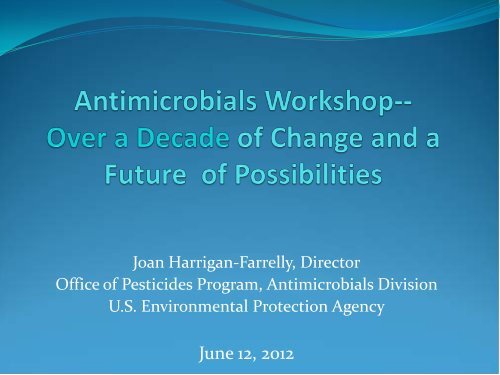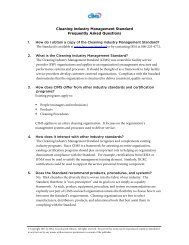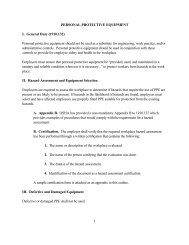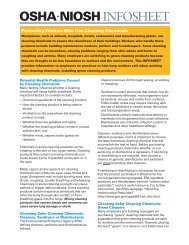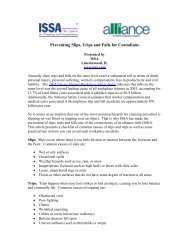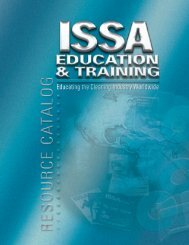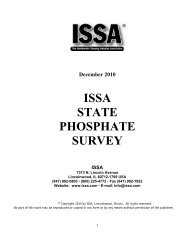Antimicrobials Division Update - ISSA.com
Antimicrobials Division Update - ISSA.com
Antimicrobials Division Update - ISSA.com
- No tags were found...
Create successful ePaper yourself
Turn your PDF publications into a flip-book with our unique Google optimized e-Paper software.
Joan Harrigan-Farrelly, DirectorOffice of Pesticides Program, <strong>Antimicrobials</strong> <strong>Division</strong>U.S. Environmental Protection AgencyJune 12, 2012
Over a Decadeof Change and a Future of Possibilities
OUTLINE• Greetings• Over a Decade of Change• Overarching Themes/Priorities• I. Improving Science• II. Advancing Protection of Public Health• III. Increasing Efficiency and Effectiveness• IV. Coordinating and Collaborating with Stakeholders• Moving into the Future• Questions3
Over a Decade of Change• In the late 1990’s, EPA partnered with industry on thesejoint workshops to bring together stakeholders to helpimprove our tools, science and relationships:• The <strong>Antimicrobials</strong> <strong>Division</strong> was a fledging program, launched toregister antimicrobial products for uses as diverse as you canimagine.• AD was designed to be an independent, one-stop-shoppingorganization.• There have been changes in our science.• Changes in the way we register products - joint jurisdiction withFDA in some areas, and in some cases, like with sterilants, they arein FDA’s domain• AD has also continuously evolved to meet the changing mandates ofFIFRA and the changing needs of stakeholders, often withsignificant input from you and others.4
Overarching Themes/Priorities• Four overarching themes and priorities that providepurpose and direction to AD’s efforts:• Improving the science behind test methods, riskassessment and decision-making,• Advancing protection of public health throughregulatory and other means,• Increasing efficiency and effectiveness in ourregistration/rereg./reg. review processes, and• Coordinating and collaborating with stakeholders(e.g., other agencies, user groups, industry groups, etc.)on issues of mutual interest.5
I. Improving the ScienceCurrent efforts for improving science:• OECD/Harmonized Guidelines and Use Dilution Method• Dr. Steve Tomasino will discuss these topics• Nanotechnology• Dr. Jed Costanza will discuss this topic• 158W• 810 Product Performance Guidelines• Exposure Data• Dr. Tim Leighton will discuss this topic• Threshold Toxicological Concern (TTC) Project• Dr. Tim McMahon will discuss this topic• Twenty-First Century Toxicology• Dr. Jennifer McLain will discuss this topic6
Use Dilution Method Revisions• The Use Dilution Method (UDM) has been in existence probablyfor as long as we’ve been registering products.• Although there have been updates, there is now a concertedeffort to update significant aspects of this test method.• In 2011, there was a workshop with a number of industryrepresentatives and independent labs• Revisions to the UDM discussed during the 2011 UDM/OECDWorkshop• Revisions submitted to AOAC Committee M (Disinfectant TestMethods) on May 1, 2012• 6-8 weeks for AOAC• Publication of the revised standards anticipated by end of July• Dr. Steve Tomasino will be discussing this in further detail7
OECD Test MethodDevelopment and ValidationBackground• The Organization for Economic Cooperation and Development (OECD) is an intergovernmentalorganization consisting of 30 industrialized countries in Europe, North America, Asia and the Pacific.• OECD’s Task Force on Biocides has as a key project the development and validation of testingmethods to determine the efficacy of biocide products used on hard surfaces. EPA is co-chairing thisproject with Australia.• The purpose of the Task Force is to revise and develop OECD Test Guidelines to help standardizetesting practices and increase mutual acceptance of pesticide studies among OECD Membercountries.Status of Testing Development• Pre-collaborative studies conducted in the Fall of 2011.• Final edits were made to the OECD Test Guidelines.• EPA's Standard Operating Procedure was updated to conform to the revisions in the OECD method.• A total of eleven labs including EPA’s Microbiology Lab participating in the collaborative.• Training was conducted by EPA on February 29-March 1, 2011.• Collaborative study was launched in late March.• Data collection underway – should be <strong>com</strong>pleted by the end of May, 2012.• Data analysis in June/early July.• Report to the OECD validation management group in late July.• Dr. Tomasino will also be addressing this in detail tomorrow.8
• BackgroundNANOTECHNOLOGY• Nanotechnology is a new part of the <strong>Antimicrobials</strong> Program.• EPA has been working hard to understand the science behindthis new technology and its impact on human health and theenvironment.• EPA is eager to work with industry to bring these innovativeproducts to the market place.• Recent Events• On 12/1/11, EPA conditionally registered its first antimicrobialnanosilver product (HeiQ AGS-20).• On January 2012, NRDC filed a petition in U.S. Court ofAppeals seeking judicial review of EPA’s conditionalregistration for HeiQ AGS-20.• EPA is issuing DCIs requiring all nanosilver registrants toproduce similar types of data based on use pattern.9
Proposed 158 W--History• Data requirements for pesticides were first codified in 1984.• Science has advanced considerably.• Statutes have changed: 1988 & 1996 FIFRA & FFDCA amendments expanded requiredassessments• The data requirements rule for conventional pesticides was promulgatedin 2007.• The antimicrobial rule has been under development for decades.• There has been lengthy and in-depth scientific and stakeholderconsultation.• 158W Proposed Rule published October 2008.• The proposed rule lists different data requirements from other pesticidesbecause of the unique uses and public health concerns associated withantimicrobials.• Final rule is still pending interagency review.10
Value of 158W• Establishes data requirements tailored for antimicrobials• Based on best available science• Provides a transparent framework• Reduced uncertainty allows better business planning• Particularly important for small businesses (2/3 of all antimicrobial firms are small)• Clarifies for applicants the information needed by EPA to make aregistration decision– Sets expectations on what data are likely to be required in all cases, and what data mayonly be required in stated circumstances• Promotes uniformity & fairness of data requirements across registrations• Improves the efficiency of registering an antimicrobial pesticide• Provides flexibility to applicants• Increases public health and environmental protection11
810 GUIDELINES• The purpose of the Product Performance Test Guidelines, 810 series, for<strong>Antimicrobials</strong> is to describe re<strong>com</strong>mended efficacy test methods,ensure consistency in data requirements, and ensure a level playing field.• These test guidelines represent an Agency effort to harmonize the testguidelines within OCSPP, as well as to harmonize the OCSPP testguidelines with those of OECD.• AD issued FR Notice of Availability for the 810 guidelines for air, textilesand water 9/15/11.• 90 day <strong>com</strong>ment period ended 12/14/11.• Final 810 guidelines for air, textiles and water are due out shortly.They will be effective 90 days after publication of the FR Notice ofAvailability.• 810 guidelines for sterilants, disinfectants and sanitizers, which werepublished for <strong>com</strong>ment in 2010, were issued final on 3/16/12 and wereeffective immediately.12
II. Advancing Protection of PublicHealthRecent & on-going efforts for protecting public health:• Reregistrations, Reg. Reviews and DCIs *• Mark Hartman will address these activities• Antimicrobial Testing Program• Guidance for registration of C. difficile label claims• Proposed prions rule______________________*--FIFRA requires EPA to review all pesticides every 15 yrs.13
The Antimicrobial Testing Program• The Agency has been testing sterilants, disinfectants andtuberculocides post registration since 1991.• The Agency is continuing to conduct its review of the healthcare andhospital disinfectants to ensure their efficacy.• A few years ago, the agency embarked on a program whereby theregulated industry was asked to submit their hospital disinfectants thatwere in production to the Agency for post market testing.• Hundreds of products were submitted for testing of Staphylococcusaureus, Pseudomonas aeruginosa and and Mycobacterium bovis BCG.• Last Direct Shipment sample received June 15, 2011• All samples received under the Direct Shipment Initiative have beentested for hospital claims and formulation chemistry.• Close to <strong>com</strong>pleting all tuberculocidal testing• The product status is on the website.• The Agency is also launching a pilot program to review food contactsurface sanitizers.14
PRIONS• EPA issued a NPRM for prion-related products that proposedto codify a prion as a “pest” in 40 CFR Part 152.5 on January26, 2011.• EPA issued a draft supplemental rule on November 16, 2011,proposing to add prions to the product performance datatable in 40 CFR Part 161 or 158W, whichever is applicable.• Draft Product Performance Test Guideline for Prion-RelatedProducts, which were reviewed by the FIFRA SAP in 2009,are also available in the supplemental rule docket for public<strong>com</strong>ment. Comment period ended January 17, 2012.• Final prion rule expected to be issued in late 2012.• No connection between this rule and the BSE cow incident.15
III. Improving Efficiency andEffectiveness• Electronic labeling and submissions• Michael Hardy and John Pott will address this topic• Assuring consistency in label reviews• Prioritizing activities in face of decreasing resources• Center of Excellence for Product Science• The goal is to have a more consistent review product,improved efficiencies, and a more nimble organization.• Products that <strong>com</strong>e in now will be reviewed by chemists fromacross OPP, not just AD, BPPD, RD or PRD.• Troubleshooting product chemistry data and CSFs• Juan Negron will provide tips on this topic• Identifying areas for improving submissions16
AD PILOTSMs. Jacqueline Campbell will be addressing thefollowing pilots in her talk:• Fragrance Change Pilot• Design for the Environment (DfE)• New Factual Statements Claim—Biodegradability• Alternative Eye Irritation Test Methods17
ELECTRONIC LABELS• Most labels still not submitted electronically• Both Industry and EPA are still working their waythrough this concept• We did review more labels electronically this past year –However, plenty of room to grow• Need to work on how to promote this as a way to savereview time and resources• Looking at new tools that can assist with reviews18
AREAS FOR IMPROVINGSUBMISSIONS• Product chemistry data• Identifying substantially similar products• Toxicity bridging data – providesupporting rationale to support bridgingargument• Data waiver requests – provide scientificrationale19
IV. Coordination and Collaboration• Today, more than ever, we find the need to coordinate withour federal partners and stakeholders:• CDC’s role is to advise healthcare institutions and the public onpractices and procedures for preventing or controlling publichealth microorganisms.• FDA’s role is to protect human health by regulating medicaldevices and accessories.• USDA’s role is to research, regulate and make publicre<strong>com</strong>mendations about how to mitigate plant and animaldiseases.• We collaborate with hospital associations to see where we canimprove.• We collaborate with industry in a number of areas, from scienceto understanding how our regulations impact the industry.• And we collaborate with our sister programs in EPA.20
evitar, si no es estrictamente necesario, las angulaciones extremasdado que requieren una alta tasa de dosis.5) Colimación y filtrado. Use la colimación para limitar el campo deradiación al área de interés ya que ello disminuye significativamentela dosis al paciente y la radiación dispersada mejorandoadicionalmente la calidad de imagen siendo que también se reduce ladosis ocupacional (situación ―win-win‖). Si dispone de colimaciónvirtual debe utilizarla. También debe usar los filtrossemitransparentes que mejoran la calidad de imagen y reduce ladosis al paciente y la radiación dispersada.6) Colóquese en una zona de baja radiación dispersa. Dependiendode su rol dentro de la sala de hemodinamia hay varias maneras decolocarse en una zona de baja radiación dispersa. Colóquese lo máslejos del tubo de Rayos X que pueda. Recuerde que la radiación seatenúa con el cuadrado de la distancia lo que significa que siduplicamos nuestra distancia al paciente, la radiación será el 25% dela inicial. Por lo tanto, cuando filme ―dé un paso atrás‖ y siempredetrás de una protección blindada. Nunca coloque sus manos en elhaz de radiación. Utilice bomba inyectora de contraste siempre quesea posible. Recuerde que las proyecciones anguladas extremas sonlas que irradian más tanto al paciente <strong>com</strong>o al operador (existe másradiación dispersada). Las proyecciones anguladas extremas irradianmás desde el lado que el haz de rayos X entra al paciente, lo quesignifica que una proyección oblicua anterior izquierda craneal es laque irradia más al operador.7) Utilice blindaje protector permanentemente. Utilice todos loselementos radioprotectivos personales que disponga: el protectortiroideo, el delantal plomado (si es en 2 piezas o con ―arnés‖ permitedisminuir el peso en los hombros y dividirlo con la cadera) lasmamparas plomadas suspendidas del techo consiguen disminuirsustancialmente la dosis a la cabeza y al cristalino. Si este dispositivoposee suficiente superficie podría evitar el uso de los lentes
Moving into the Future• 21 st Century Toxicology / Non-Animal Testing• Expanding our scientific knowledge in all the areas – Nanotechnology,efficacy• AEATF (exposure task force) efforts to develop worker exposure datawill be useful for developing risk assessments• Working more collaboratively with our partners in NAFTA and OECDtowards harmonization• Increased coordination with all involved stakeholders• Open dialogue with all those involved with ensuring the protection ofpublic health in our nation’s hospitals, HMO’s, clinics, nursing homes,and urgent care facilities• Increased coordination with all stakeholders• Influx of data from DCIs for Registration Review• Completely electronic submission & processing22
What is on the Horizon?Hopefully, these two days will help chart the course ofwhat we should be doing, and where we should beheading in the future23
QUESTIONS?24


